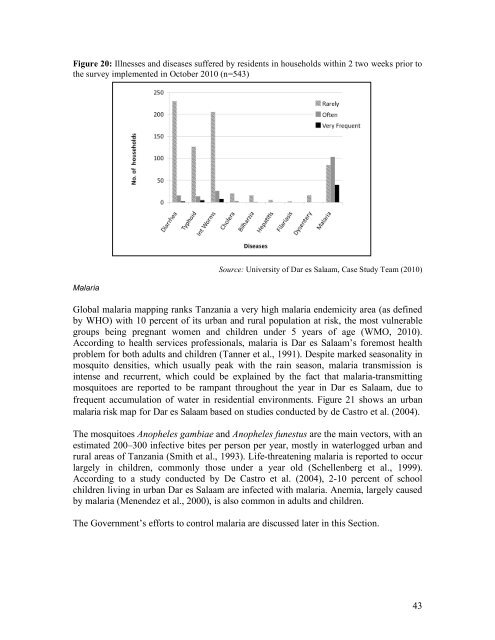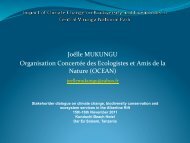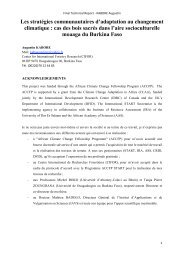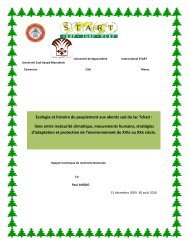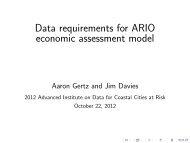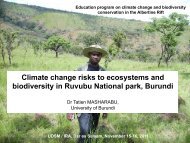Urban Poverty & Climate Change in Dar es Salaam, Tanzania:
Urban Poverty & Climate Change in Dar es Salaam, Tanzania:
Urban Poverty & Climate Change in Dar es Salaam, Tanzania:
You also want an ePaper? Increase the reach of your titles
YUMPU automatically turns print PDFs into web optimized ePapers that Google loves.
Figure 20: Illn<strong>es</strong>s<strong>es</strong> and diseas<strong>es</strong> suffered by r<strong>es</strong>idents <strong>in</strong> households with<strong>in</strong> 2 two weeks prior to<br />
the survey implemented <strong>in</strong> October 2010 (n=543)<br />
Malaria<br />
Source: University of <strong>Dar</strong> <strong>es</strong> <strong>Salaam</strong>, Case Study Team (2010)<br />
Global malaria mapp<strong>in</strong>g ranks <strong>Tanzania</strong> a very high malaria endemicity area (as def<strong>in</strong>ed<br />
by WHO) with 10 percent of its urban and rural population at risk, the most vulnerable<br />
groups be<strong>in</strong>g pregnant women and children under 5 years of age (WMO, 2010).<br />
Accord<strong>in</strong>g to health servic<strong>es</strong> prof<strong>es</strong>sionals, malaria is <strong>Dar</strong> <strong>es</strong> <strong>Salaam</strong>’s foremost health<br />
problem for both adults and children (Tanner et al., 1991). D<strong>es</strong>pite marked seasonality <strong>in</strong><br />
mosquito densiti<strong>es</strong>, which usually peak with the ra<strong>in</strong> season, malaria transmission is<br />
<strong>in</strong>tense and recurrent, which could be expla<strong>in</strong>ed by the fact that malaria-transmitt<strong>in</strong>g<br />
mosquito<strong>es</strong> are reported to be rampant throughout the year <strong>in</strong> <strong>Dar</strong> <strong>es</strong> <strong>Salaam</strong>, due to<br />
frequent accumulation of water <strong>in</strong> r<strong>es</strong>idential environments. Figure 21 shows an urban<br />
malaria risk map for <strong>Dar</strong> <strong>es</strong> <strong>Salaam</strong> based on studi<strong>es</strong> conducted by de Castro et al. (2004).<br />
The mosquito<strong>es</strong> Anophel<strong>es</strong> gambiae and Anophel<strong>es</strong> fun<strong>es</strong>tus are the ma<strong>in</strong> vectors, with an<br />
<strong>es</strong>timated 200–300 <strong>in</strong>fective bit<strong>es</strong> per person per year, mostly <strong>in</strong> waterlogged urban and<br />
rural areas of <strong>Tanzania</strong> (Smith et al., 1993). Life-threaten<strong>in</strong>g malaria is reported to occur<br />
largely <strong>in</strong> children, commonly those under a year old (Schellenberg et al., 1999).<br />
Accord<strong>in</strong>g to a study conducted by De Castro et al. (2004), 2-10 percent of school<br />
children liv<strong>in</strong>g <strong>in</strong> urban <strong>Dar</strong> <strong>es</strong> <strong>Salaam</strong> are <strong>in</strong>fected with malaria. Anemia, largely caused<br />
by malaria (Menendez et al., 2000), is also common <strong>in</strong> adults and children.<br />
The Government’s efforts to control malaria are discussed later <strong>in</strong> this Section.<br />
43


